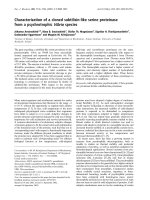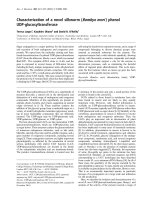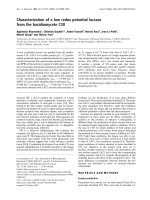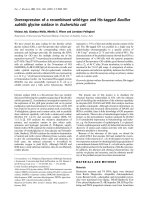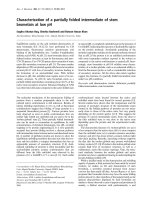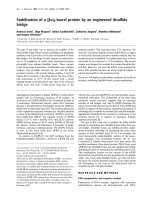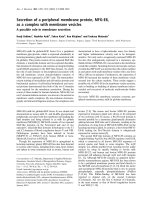Báo cáo y học: "Assessment of epicutaneous testing of a monovalent Influenza A (H1N1) 2009 vaccine in egg allergic patients" potx
Bạn đang xem bản rút gọn của tài liệu. Xem và tải ngay bản đầy đủ của tài liệu tại đây (350.85 KB, 4 trang )
REVIEW Open Access
Assessment of epicutaneous testing of a
monovalent Influenza A (H1N1) 2009 vaccine in
egg allergic patients
Tracy Pitt
*
, Chrystyna Kalicinsky, Richard Warrington, Nestor Cisneros
Abstract
Background: H1N1 is responsible for the first influenza pandemic in 41 years. In the fall of 2009, an H1N1 vaccine
became available in Canada with the hopes of reducing the overall effect of the pandemic. The purpose of this
study was to assess the safety of administering 2 different doses of a monovalent split virus 2009 H1N1 vaccine in
egg allergic patients.
Methods: Patients were skin tested to the H1N1 vaccine in the outpatient paediatric and adult allergy and
immunology clinics of the Health Sciences Centre and Children’s Hospital of Winnipeg, Manitoba Canada.
Individuals <9 years of age were administered 1.88 μg’s of hem-agglutinin antigen per 0.25 ml dose and
individuals ≥9 years were administer ed 3.75 μg’s of hemagglutinin antigen per 0.5 ml dose. Upon determination of
a negative skin test, the vaccine was administered with a 30 minute observation period.
Results: A total of 61 patients with egg allergy (history of an allergic reaction to egg with either positive skin test
&/or specific IgE to egg >0.35 Ku/L) were referred to our all ergy clinics for skin testing to the H1N1 vaccine. 2
patients were excluded, one did not have a skin prick test to the H1N1 vaccine (only vaccine administration) and
the other passed an egg challenge during the study period. Ages ranged from 1 to 27 years (mean 5.6 years).
There were 41(69.5%) males and 18(30.5%) females. All but one patient with a history of egg allergy, positive skin
test to egg and/or elevated specific IgE level to egg had negative skin tests to the H1N1 vaccine. The 58 patients
with negative skin testing to the H1N1 vacci ne were administer ed the vaccine and observed for 30 minutes post
vaccination with no adverse results. The patient with the positive skin test to the H1N1 vaccine was also
administered the vaccine intramuscularly with no adverse results.
Conclusions: Despite concern regarding possible anaphylaxis to the H1N1 vaccine in egg allergic patients, in our
case series 1/59(1.7%) patients with sensitization to egg were also sensitized to the H1N1 vaccine. Administration
of the H1N1 vaccine in egg all ergic patients with negative H1N1 skin tests and observation is safe. Administering
the vaccine in a 1 or 2 dose protocol without skin testing is a reasonable alternative as per the CSACI guidelines.
Background
The current swine-origin influenza A (H1N1) strain
(S-OIV), also known as the swine flu, was responsible
for numerous emergency room visit s, hospital admis-
sions, complications and deaths worldwide in 2009. A
recent Canadian review of 58 children admitted to the
Hospital for Sick Children with H1N1 influenza, found
that 29% of these children had radiographic changes
compatible with pneumonia. In addition, these children
were significantly more likely to h ave a comorbid diag-
nosis of asthma than children with seasonal influenza
[1]. The burden of illness as demonstrated by hospital
admissions was especially evident amongst both pedia-
tric patients and the elderly. A review of laboratory-con-
firmed cases in Ontario found the highest risk o f
hospitalization was among infants less than 1 year of
age and in the elderly greater than 65 years o f age [2].
The province of Manitoba was especially affected in
2009. One series reports 894 confirmed cases of H1N1
in Manitoba from April 2
nd
to September 25
th
2009, of
* Correspondence:
Section of Allergy & Clinical Immunology, Health Sciences Centre, Winnipeg,
Manitoba, Canada
Pitt et al. Allergy, Asthma & Clinical Immunology 2011, 7:3
/>ALLERGY, ASTHMA & CLINICAL
IMMUNOLOGY
© 2011 Pitt et al; licensee BioMed Central Ltd. This is an Open Access article distributed under the terms of the Creative Commons
Attribution License ( which permits unrestricted use, distribution, and reproduction in
any medium, pro vided the original work is properly cited.
whom 23% were admitted to hospital and 6% to the
intensive care unit [3].
The rapid global spread of this virus prompted the
World Health Organization to declare an H1N1 pan-
demic in June of 2009. In the fall of 2009, a vaccine was
introduced in hopes of reducing the burden of this
virus. Patients with IgE mediated allergy to egg have in
the past been advised to avoid the influenza vaccine due
to the egg co ntent of the vaccine. Influenza vaccines are
developed by inoculating embryonated chicken eggs
with virus and thus contain ovalbumin. A recent review
of ovalbumin content in H1N1 vaccines found a range
of actual ovalbumin content of 0.064-1.411 mcg/ml [4].
Thepurposeofthisstudywastoassessthesafetyof
administering 2 different doses of a monovalent split
virus 2009 H1N1 vaccine in egg allergic patients.
Methods
Patients with a history of probable egg allergy and can-
didates for receiving the H1N1 vaccine were referred to
the pediatric and adult allergy and immunology clinics
for administration of the H1N1 vaccine. A patient was
labeled as egg allergic if they had a convincing clinical
history of an IgE mediated reaction to egg ingestion
(including symptoms of urticaria, angioedema, cough,
other breathing difficulties, wheeze, pruritus, flushing,
rhinoconjunctivitis, throat tightness, gastrointestinal
complaints, cyanosis, and circulatory collapse) within
2 hours. They either had positive epicutaneous testing
to egg white allergen and/or were immunocap positive
to egg as part of confirming the clinical diagnosis.
The Canadian Society of Allergy and Clinical Immu-
nology ( CSACI) recommends administr ation of the
H1N1 vaccine based on 2 risk categories of patient with
egg allergy [5]. The first category are lower risk patients
(with mild gastrointestinal or mild local skin reaction,
tolerating ingestion of small amounts of egg, or positive
skin/specific IgE test to egg without knowingly exposed
to egg) or higher risk (previous respiratory or cardiovas-
cular reaction, generalized hives or those with poorly
controlled asthma). For lower risk patients the vaccine
is recommended to be administered with a 60 minute
observation period. For patients at higher risk, or if the
risk is unknown, an initial test dose with 10% of the
total dose followed by 30 minutes of observation. If
there is no reaction after 30 minutes, the remaining 90%
of the vaccine can be given with observation for 60 min-
utes. Children who tolerate the split dose and who
require a second dose (first time receiving influenza vac-
cine) can receive the next dose in one injection. For all
of the patients in this study, it was decided that if a skin
test was found to be negative, the entire dose of the vac-
cine would be given with a 30 minute observation
period.
Patients were skin tested to the H1N1 vaccine in the
outpatient pediatric and adult allergy and immunology
clinics of the Health Sciences Centre and Children’s
Hospital of Winnipeg, Manitoba, Canada. Upon deter-
mination o f a negative skin test, the vaccine was a dmi-
nistered with a 30 minute observation period. Children
under 9 years of age were administered 1.88 μg’ sof
hem-agglutinin antigen per 0.25 ml dose and individuals
≥ 9 years were administered 3.75 μg’s of hemagglutinin
antigen per 0.5 ml dose intramuscularly based on the
above protocol. Control subjects consisted of patients
with no history of egg allergy , who were referred to the
allergy and immunology clinics due to various reasons
including a history of a previous reaction to the influ-
enza vaccine.
Epicutaneous testing was performed via the prick lanc-
eter method using egg white extract (ALK Abelló), ARE-
PANRIX H1N1 AS03 Adjuvanted H1N1 vaccine
(GlaxoSmithKline), along with a positive (histamine) and
negative (saline) control (ALK Abelló). A mean wheal
diameter of 3 mm or greater than elicited by the negative
control was considered positive. The ovalbumin content
of the AREPANRIX H1N1 AS03 Adjuvanted H1N1 vac-
cine used had a stated allowable limit of 165ng/ml.
Results
Therewereatotalof61patientswithhistoryofegg
allergy referred to the pediatric and adult allergy and
immunology clinics. 2 patients were excluded, one did
not have s kin prick testing to the vaccine (only vaccine
administration), and the other passed an egg challenge
during the study period. Of the remaining 59 patients,
there were 41 (69.5%) males and 18 (30.5%) females ran-
ging from age 1 through 27 years with a mean of 5.6
years. There were 8 control patients with no hist ory of
egg allergy, aged 13-77 years (mean 45.5 years) with 7
females (87.5%) and 1 male(12.5%). Demographics are
shown in table 1. A comorbid diagnosis of asthma, or
atopic dermatitis or allergic rhinitis was found in 29
Table 1 Demographics and safety of H1N1 vaccine
administration to study groups
Patients with
Egg allergy
Control
Subjects
Number of patients 59 10
Age in years (mean) 1-27(5.6) 13-77(45.5)
Male sex (percentage) 41(69.5%) 1(12.5%)
Positive skin test response to H1N1
vaccine
10
Reaction post-vaccination None None
Exact 95% Confidence Interval for
percentage who can safely receive this
vaccine
90.23%, 99.67% 63.06%,
100%
Pitt et al. Allergy, Asthma & Clinical Immunology 2011, 7:3
/>Page 2 of 4
(49.2%), 22 (37.3%), 8 (13.6%) respectiv ely of all patients
referred (Figure 1).
All 59 patients had either a skin prick test performed to
egg and/or a specific IgE level to egg white or egg yolk.
42 patients had both skin prick test to egg as well as spe-
cific IgE levels to egg performed. Of the 46 patients that
had a specific IgE level performed to egg white, the mean
egg white specific IgE level was 16.2Ku/L. Of the
47 patie nts that had skin prick testing to egg white com-
mercial extract, the mean wheal size was 9.9 mm. Egg
specific IgE levels and skin testing results are seen in
Figure 2 and 3 respectively.
Skin testing to the H1N1 vaccine was performed in 59
patients and was found to be positive in only one (1.7%)
patient. All patients with negative skin prick testing to
the H1N1 vaccines were administered a dose of the
H1N1 vaccine regardless of their risk category. The
patients were then observed for 30 minutes after vaccina-
tion and no adverse events were noted. The one patient
with a positive skin test had a H1N1 skin test diameter of
4 mm. Due to the H1N1 epidemic, it was decided that
the benefits of vaccination outweighed the risks. After
discussion with the patient’s parents regarding t he risks
and benefits of vaccine administration or omission, the
vaccine was administered to this individual, 10% of the
dose initially then 90% with 30 minute observation after
each injection. There were no adverse results.
Of note, this 2 year old male with a positive skin
prick test to the H1N1 vaccine had a wheal diameter
of 16 mm to egg white, comorbid diagnoses of
asthma and atopic dermatitis as well as allergy to f ish
and shellfish. There were only 4 individuals with a
larger or equivalent wheal diameter to egg than this
patient with 2 at 18 mm and one at 17 mm and one
at 16 mm. Of these four patients, one was not other-
wise atopic, one had a comorbid diagnosis of asthma,
two had comorbid diagnosis of both asthma and
allergic rhinitis and none had allergy to fish or
shellfish.
Discussion
A novel 2009 influenza H1N1 virus was responsible for
the first influenza pandemic in over 4 decades. H1N1
associated hospital admissions have been described in
several Canadian studies [6,7]. With in months of the
initial identified c ases of H1N1, a vaccine was produced
in hopes of reducing morbidity and m ortality associated
with this virus . Our series demonstrated that a negative
skin prick test and challenge are highly predictive of
safely tolerating vaccine administration. In the past, influ-
enza vaccines have been contraindicated in patients with
egg allergy due to the ovalbumin content of the vaccine.
However, previous studies have demonstrated that
Figure 1 Comorbidity of Asthma, Atopic Dermatitis and
Allergic Rhinitis.
Figure 2 Egg Specific IgE levels in Ku/L.
Figure 3 Wheal to egg white in milimitres.
Pitt et al. Allergy, Asthma & Clinical Immunology 2011, 7:3
/>Page 3 of 4
patients with egg allergy can receive an influenza vaccine
in a 2 dose protocol when the vaccine contains ≤ 1.2
micrograms/ml of egg protein after appropriate skin test-
ing [8]. A recent Canadi an study also suggested that skin
testing to the flu vaccine in patients with egg allergy is
not necessary. Here Ga gnon et al found that none of the
over 800 patients with co nfirmed egg allergy had symp-
toms of anaphylaxis in the follow up period [9].
Similarly, our series of 59 patients also demonstrates
that a 1 dose protocol in children and adults can be
safely tolerated when the vaccine contains ≤165 ng/mL
of ovalbumin. In addition, an egg allergic patient with a
minimally positive skin test of 4 mm also tolerated vac-
cine administration with no adverse events in two half
hour observation periods.
Conclusions
TheH1N1vaccineappearstobesafetoadministerto
individuals with a diagnosis of egg allergy. One of our 59
(1.7%) patients did have a positive skin prick test to the
H1N1 vaccine along with a positive skin prick test to egg
white, elevated specific IgE levels to egg white and egg
yolk, and tolerated vaccine administration via challenge.
Administration of the H1N1 vaccine to individuals with
egg allergy appears to be safe. This study has shown that
almost all skin tests to the H1N1 vaccine were negative
making the role of skin testing questionable. Administer-
ing the vaccine in a 1 or 2 dose protocol without skin test-
ing is a reasonable alternative as per the CSACI guidelines.
Authors’ contributions
All authors read and approved the final manuscript.
Competing interests
The authors declare that they have no competing interests.
Received: 8 September 2010 Accepted: 11 February 2011
Published: 11 February 2011
References
1. O’Riordan S, Barton M, Yau Y, Read S, Allen U, Tran D: Risk factors and
outcomes among children admitted to hospital with pandemic H1N1
influenza. CMAJ 2010, 182:39-44.
2. Tuite A, Greer A, Whelan M, Winter A, Lee B, Yan P, Wu J, Moghadas S,
Buckeridge D, Pourbohloul B, Fisman D: Estimated epidemiologic
parameters and morbidity associated with pandemic H1N1 influenza.
CMAJ 2010, 182:131-136.
3. Zarychanski R, Stuart T, Kumar A, Doucette S, Elliot L, Ketter J, Plummer F:
Correlates of severe disease in patients with 2009 pandemic influenza
(H1N1) virus infection. CMAJ 2010, 182:257-264.
4. Waibel K, Gomez R: Ovalbumin content in 2009 to 2010 seasonal and
H1N1 monovalent influenza vaccines. J Allergy Clin Immunol 2010,
125:749-751.
5. The Canadian Society of Allergy and Clinical Immunology: Statement:
administration of H1N1 and seasonal influenza vaccine to egg allergic
individuals. [ />Accessed July 23, 2010.
6. Helferty M, Vachon J, Tarasuk J, Rodin R, Spika J, Pelletier L: Incidence of
hospital admissions and severe outcomes during the first and second
waves of pandemic (H1N1) 2009. CMAJ 2010, 182:1981-7.
7. Kumar A, Zarychanski R, Pinto R, et al: Critically ill patients with 2009
influenza infection in Canada. JAMA 2009, 302:1872-1879.
8. James J, Zeiger R, Lester M, Fassano M, Gern J, Mansfield L, Schwartz H,
Sampson H, Windom H, Machtinger S, Lensing S: Safe administration of
influenza vaccine to patients with egg allergy. J Pediatrics 1998,
133:624-8.
9. Gagnon R, Primeau M, Des Roches A, Lemire C, Kafan R, Carr S, Ouakki M,
Benoit M, De Serres B: Safe vaccination of patients with egg allergy with
an adjuvanted pandemic H1N1 vaccine. J Allergy Clin Immunol 2010,
126:317-23.
doi:10.1186/1710-1492-7-3
Cite this article as: Pitt et al.: Assessment of epicutaneous testing of a
monovalent Influenza A (H1N1) 2009 vaccine in egg allergic patients.
Allergy, Asthma & Clinical Immunology 2011 7:3.
Submit your next manuscript to BioMed Central
and take full advantage of:
• Convenient online submission
• Thorough peer review
• No space constraints or color figure charges
• Immediate publication on acceptance
• Inclusion in PubMed, CAS, Scopus and Google Scholar
• Research which is freely available for redistribution
Submit your manuscript at
www.biomedcentral.com/submit
Pitt et al. Allergy, Asthma & Clinical Immunology 2011, 7:3
/>Page 4 of 4
